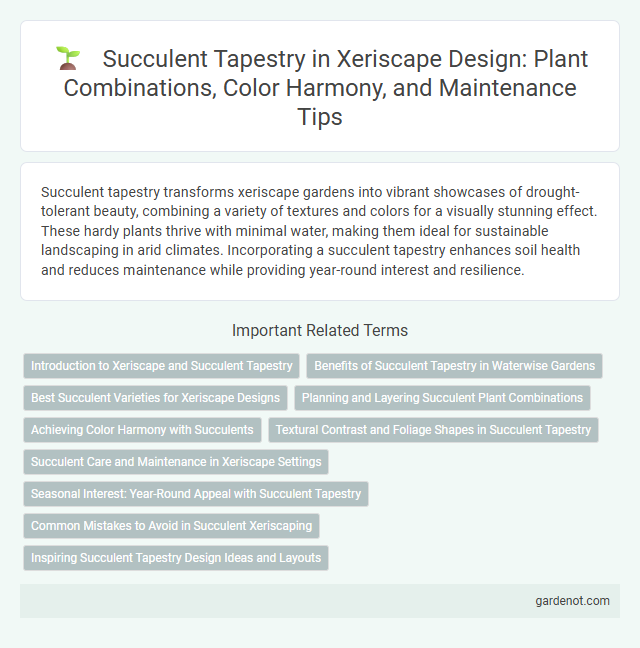Succulent tapestry transforms xeriscape gardens into vibrant showcases of drought-tolerant beauty, combining a variety of textures and colors for a visually stunning effect. These hardy plants thrive with minimal water, making them ideal for sustainable landscaping in arid climates. Incorporating a succulent tapestry enhances soil health and reduces maintenance while providing year-round interest and resilience.
Introduction to Xeriscape and Succulent Tapestry
Xeriscape is a water-efficient landscaping method that uses drought-tolerant plants to minimize irrigation needs. Succulent tapestry is a popular xeriscape design featuring diverse succulent species arranged to create vibrant, low-maintenance ground cover. This technique conserves water, reduces soil erosion, and enhances garden aesthetics in arid climates.
Benefits of Succulent Tapestry in Waterwise Gardens
Succulent tapestry enhances waterwise gardens by significantly reducing irrigation needs due to succulents' natural drought tolerance and efficient water storage. Their dense, low-growing mats minimize soil erosion and suppress weed growth, improving garden health and low-maintenance. Succulent tapestry also boosts biodiversity by providing habitat and food for pollinators, contributing to sustainable and resilient xeriscape designs.
Best Succulent Varieties for Xeriscape Designs
Aeoniums, Echeverias, and Sedums stand out as the best succulent varieties for xeriscape designs due to their drought tolerance and low maintenance requirements. These succulents thrive in arid climates, offering vibrant colors, diverse textures, and unique rosette shapes that enhance any xeriscape tapestry. Incorporating these varieties ensures water-efficient landscaping while providing year-round visual interest and resilience to harsh environmental conditions.
Planning and Layering Succulent Plant Combinations
Effective planning and layering of succulent plant combinations in xeriscape designs enhance water efficiency and aesthetic appeal. Arrange succulents by size, texture, and color to create visual depth while ensuring each plant's water requirements align with its placement. Incorporating drought-tolerant species such as echeveria, sedum, and aloe in layered groupings optimizes space and promotes healthy growth.
Achieving Color Harmony with Succulents
Achieving color harmony with succulents involves selecting varieties with complementary hues, such as the deep purples of Echeveria 'Black Prince' paired with the soft greens of Sedum morganianum. Incorporating succulents with varying textures and shades, like the powdery blue of Pachyphytum oviferum alongside the bright reds of Crassula capitella, enhances visual balance. Strategic placement and use of contrasting colors create a dynamic yet cohesive succulent tapestry ideal for xeriscape gardens.
Textural Contrast and Foliage Shapes in Succulent Tapestry
Succulent tapestry showcases a rich textural contrast through the interplay of smooth, spiky, and rosette-shaped foliage, creating dynamic visual interest. Varieties like Echeveria offer soft, rounded leaves that complement the angular, pointed forms of Agave and Aloe species. This deliberate combination of diverse foliage shapes enhances both depth and dimension in xeriscape designs, promoting water-efficient landscaping with aesthetic appeal.
Succulent Care and Maintenance in Xeriscape Settings
Succulent tapestry in xeriscape settings thrives with minimal water and well-draining soil, making succulent care efficient and eco-friendly. Regular removal of dead leaves and occasional fertilization during the growing season enhance plant health and vibrant growth. Monitoring sunlight exposure and protecting succulents from extreme temperatures prevent stress and maintain a lush, drought-resistant landscape.
Seasonal Interest: Year-Round Appeal with Succulent Tapestry
Succulent tapestry offers vibrant seasonal interest by showcasing diverse textures and colors throughout the year, making it an ideal xeriscape choice for sustainable landscapes. Different succulent varieties bloom in various seasons, providing continuous visual appeal and minimizing irrigation requirements. This year-round attraction enhances garden aesthetics while conserving water and supporting drought-resistant planting strategies.
Common Mistakes to Avoid in Succulent Xeriscaping
Overwatering is a common mistake that can lead to root rot in succulent xeriscaping, as these plants thrive in dry conditions with infrequent watering. Planting succulents too close together reduces airflow and increases the risk of fungal diseases, hindering healthy growth. Choosing non-native species without considering local climate and soil conditions often results in poor adaptation and higher maintenance needs in xeriscape designs.
Inspiring Succulent Tapestry Design Ideas and Layouts
Succulent tapestry designs combine diverse succulent varieties to create vibrant, textured living walls that conserve water and enhance outdoor aesthetics. Popular layouts feature geometric patterns, cascading arrangements, and color gradients that highlight unique leaf shapes and hues, ideal for xeriscape gardens in arid climates. Incorporating drought-tolerant succulents such as Echeveria, Sedum, and Crassula ensures sustained growth and minimal irrigation, making these tapestries both beautiful and eco-friendly.
Succulent tapestry Infographic

 gardenot.com
gardenot.com